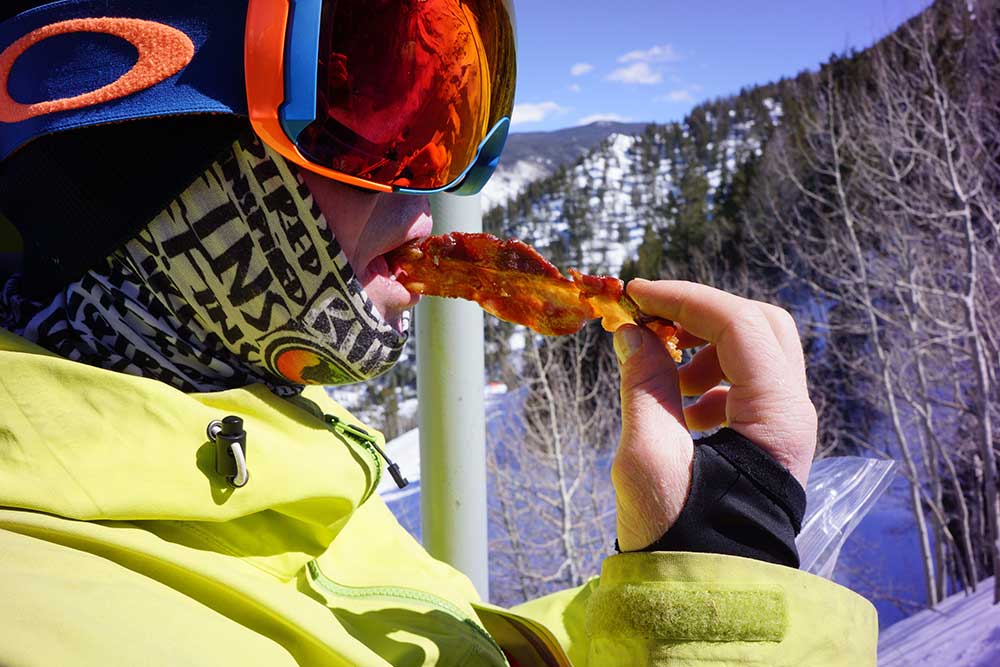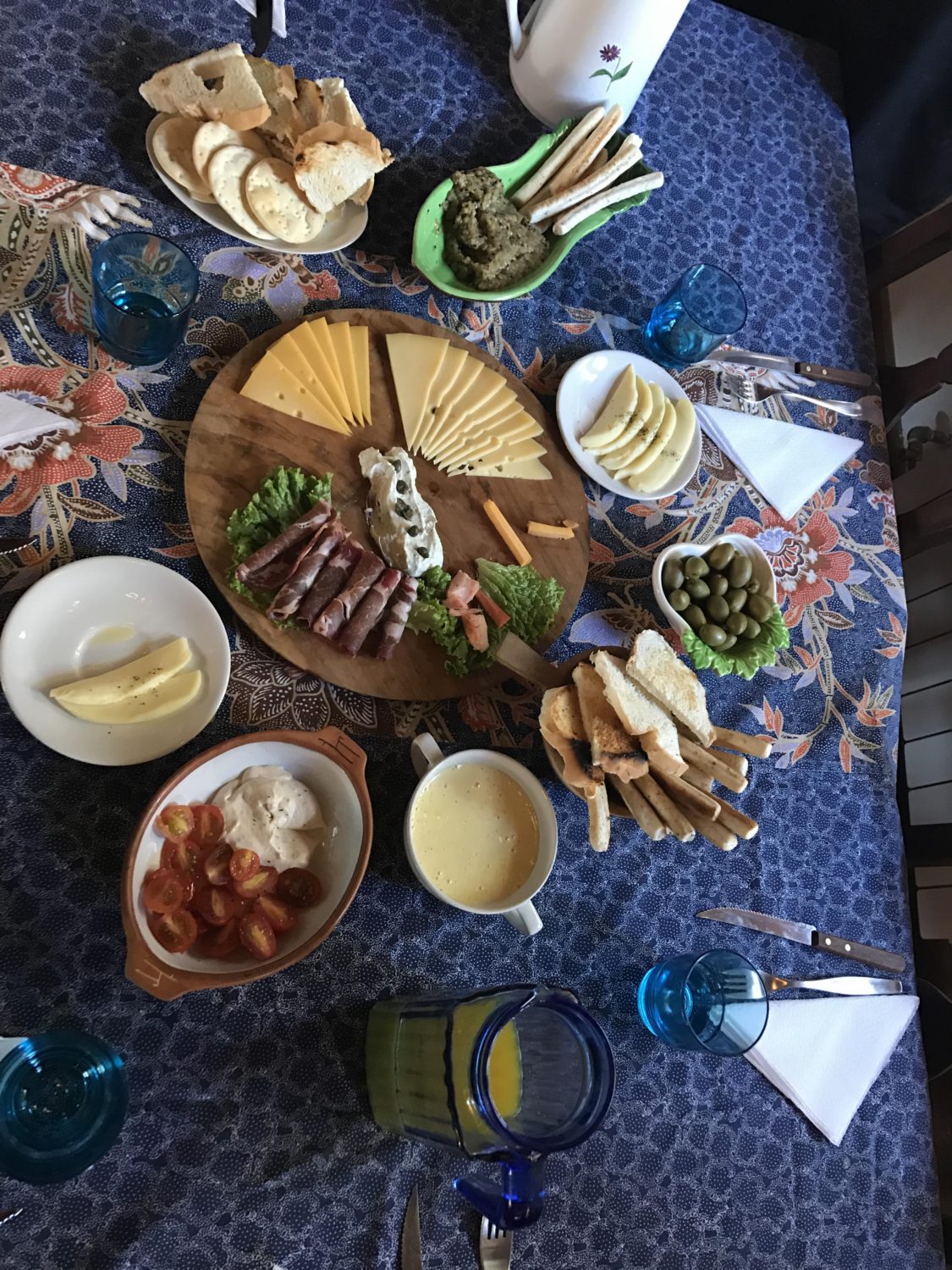
This post was submitted by guest author Haley Mueller
Hundreds of thousands of adults flock to ski resorts in the winter, and with the high number of adults comes a high number and variety of injuries. Injury rates in recreational skiing are relatively low, ranging from 2.4 to 2.6 per 1,000 activity days. Many factors lead to injuries, but one of the lesser-mentioned factors is nutrition.
While inadequate nutrition can’t cause skiing injuries, it can build fatigue that may lead to a ski injury. There is a straightforward way to attenuate this fatigue; eat adequate calories, especially carbohydrates and perhaps small amounts of protein, and drink fluids during skiing. One particular reason for fatigue could be low glycogen stores. Your body stores glucose, the sugar you get from foods like fruit and grains (i.e., spaghetti), in the form of glycogen. Glycogen is just a bunch of glucose molecules linked together.
During exercise, your muscles use stored glycogen for energy production. This glycogen is broken down to produce adenosine triphosphate (ATP), which then supplies the energy for muscle contraction. After a long day of skiing, glycogen stores are considerably depleted. This depletion of glycogen stores and muscle stress leads to fatigue and decreased muscular coordination. The resulting fatigue and decreased muscular coordination may be critical factors in injuries sustained during skiing. In a practical sense, the resulting fatigue may make it difficult to counteract a loss of balance or ski as many runs as we want.
In essence, when muscles fatigue, there is a decrease in muscle activation. This means that fewer contractile units of the muscle are active, giving the body less force to produce if something goes wrong. Essentially, the resulting fatigue leaves a skier more open for a fall.

So, what do you do about this fatigue? You eat. Without proper nutrition, your performance will most likely suffer. First, you must eat enough calories. Eat a well-balanced breakfast, and don’t wait until you can eat the whole refrigerator. Second, you must eat carbohydrates and small amounts of protein before, during, and after skiing. Research has shown that eating carbohydrates and small amounts of protein before, during, and after exercise can delay fatigue and speed recovery. Carbohydrates should be fast oxidizing. Some examples of easy and quick digesting carbohydrates include a Gatorade, a granola bar, a Clif Bar shot blocks, or fruit. A small snack should be eaten every 60 to 90 minutes to get enough carbohydrates in.
Having different types of carbohydrates during exercise is also recommended. This means carbohydrates can be a mix of glucose and fructose. Fructose is found in fruit and honey. Do take into consideration, though, that too much fructose can cause digestive upset. So, individual tolerances may need to be tested, and fructose should be kept to an amount that does not cause digestive issues. After exercise, a high glycemic index (GI) carbohydrate with some protein is recommended. Glycemic index has to do with how much a particular food can make blood sugar increase after eating that food. High GI foods cause a rapid increase in blood glucose levels.
So why am I telling you to eat a high GI carbohydrate after skiing? One of the essential nutritional factors for adequate recovery after exercise is resynthesizing glycogen. Your glycogen is restored faster following a high GI meal. The general recommendation is to eat a high GI carbohydrate with some protein following exercise for adequate recovery. An example would be white rice or a baked potato with a protein option and some vegetables. A complete list of the GI of some common foods can be found here: https://www.health.harvard.edu/diseases-and-conditions/glycemic-index-and-glycemic-load-for-100-foods
Fluid also needs to be ingested while skiing. Fluid should be consumed between runs in the chairlift line and on the chairlift, not just during lunch in the lodge. Performance deteriorates without liquid, and the cold also causes you to voluntarily drink less and use the restroom more.
In conclusion, what does all of this look like? First, have a good, filling breakfast full of carbohydrates. Pancakes, waffles, and oatmeal are always easy and can be a delightful morning breakfast, especially for young kids. Shortly before skiing, quick and easy digesting carbohydrates such as Gatorade, fruit, gels or shot blocks are a good idea. On the ski hill, carbohydrates should be eaten with protein. High GI carbohydrates, along with protein, should be eaten after skiing. High GI carbohydrates include white bread, potatoes, white rice, and honey. Easy pocket options are a peanut butter and jelly sandwich, hard candies, sliced apples with a cheese stick, gels, and shot blocks. A post-skiing meal may look like a burrito wrapped in a white tortilla with potatoes, a protein of your choice, and whatever other fixings you add, such as avocado or cheese. White rice with some protein and vegetables is another great option.
In essence, don’t come to the ski hill with an empty stomach, and don’t wait till lunchtime to eat.

Hi! I’m a masters student at Montana State University. I’m getting my masters in exercise physiology and nutrition and I completed my bachelors degree in food and nutrition at MSU as well. Nutrition and exercise science is my jam!
Great read Mystery Guest Author! Not just basics about macros. Would love to know your academic/professional background. As a diabetic who loves to snowboard aggressively, I already do a lot of what you wrote. Cheers!